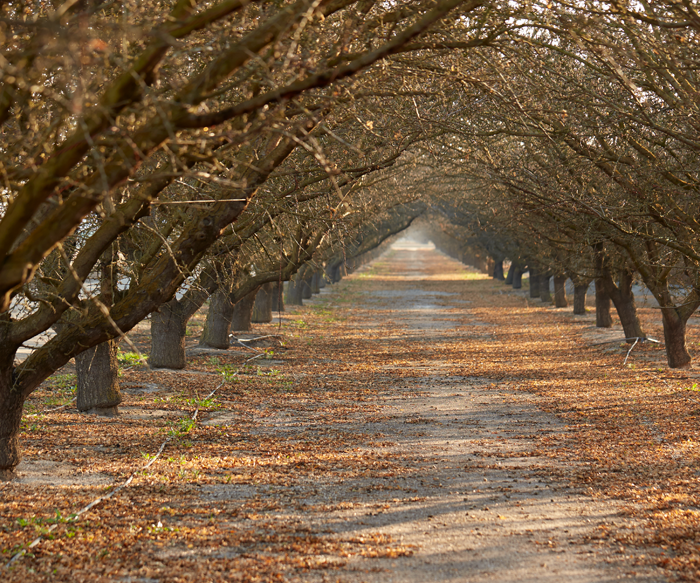Think of late-season and postharvest irrigation as “paying it forward” for next year’s crop. The same is true of accurately evaluating postharvest nutrition needs, which also will vary from orchard to orchard.
 By the end of September, flower formation inside the buds is coming to an end and next year’s crop yield potential is set. The principle is simple: greater flower development in the current season may result in greater return the following season. Taking care of those recently developed buds with good water and nutrient management will maximize next year’s fruit-set.
By the end of September, flower formation inside the buds is coming to an end and next year’s crop yield potential is set. The principle is simple: greater flower development in the current season may result in greater return the following season. Taking care of those recently developed buds with good water and nutrient management will maximize next year’s fruit-set.
Creating an irrigation and nutrient management checklist can help you ensure that proper action is taken to prepare your trees for the following season.
Step 1: Ensure Optimum Irrigation, Reference the Continuum
During this time of year, in particular, it’s crucial to for growers to ensure the irrigation system is working uniformly throughout the orchard. An informative source to help growers better understand irrigation management — both postharvest and year-round — is the Almond Irrigation Improvement Continuum. The Continuum provides a wide-ranging look at a grower’s site-specific irrigation system with the goal of improved efficiency and effectiveness.
This resource, developed by the Almond Board of California (ABC) in partnership with respected technical experts, provides a step-by-step explanation of irrigation management and scheduling practices related to the following concepts:
- Measuring irrigation system performance and efficiency
- Estimating orchard water requirements based on evapotranspiration
- Determining applied water
- Evaluating soil moisture
- Evaluating plant water status
Step 2: Take Extra Care in a Fall Nitrogen Application
Once you double check that your irrigation systems are functioning properly, it is time to evaluate whether any nitrogen (N) is needed in the fall. Postharvest nitrogen applications may be needed to supply your trees’ N demand; however, N applications can also be inefficient and unhelpful, especially in any of the following situations:
- Trees are already adequate in N levels per July/August leaf analysis: Leaf analysis is one of the best indicators to determine N status. If the July leaf N value is higher than 2.5%, a fall N application is likely not necessary.
- There is sufficient N available in the to supply tree demand: If you want to have a better indication of your soil’s N levels, consider conducting a soil sample. However, make sure to draw your sample from active roots and closely follow laboratory protocols.
- Tree health is suboptimal when you plan to apply N: This may be the case if, for instance, your trees are too stressed during harvest or will be too stressed postharvest due to dry down, water limitations, salinity, etc. Trees in suboptimal health will likely have very few leaves in the canopy and those leaves will look yellow.
Applying N when your trees have poor health conditions, or when your trees and soils already have sufficient soil levels, will likely result in N loss through leaching or gaseous losses. N loss subsequently brings little to no benefit to flower development.
Step 3: Foliar Sprays: Boron and Zinc
Postharvest is also a good time to consider nutrient uptake through the trees’ leaves via foliar applications. During this season, there are two key micronutrients to consider: boron and zinc.
Boron (B) plays a key role during flowering as it promotes the elongation of the pollinic tube, therefore promoting fruit set. Maintaining adequate B in your tree buds is especially beneficial during bloom. However, too much or too little B will have the opposite effect – reduced fruit set.1 The adequate range for B is 60-160 ppm, and B will likely not need to be applied if levels are at the upper end of this range.
Growers often apply large amounts of zinc sulfate spray in the fall to improve tree Zinc (Zn) status. However, while a fall Zn application may be beneficial to control rust inoculum by promoting leaf drop, research shows that this application does not increase the Zn concentration in trees. In fact, new findings suggest that Zn uptake in trees mostly occurs when Zn is applied in early spring.2
For more information on nutrient recommendations and critical ranges, visit Almonds.com/Nutrients and UC Davis’ Almond Nutrients & Fertilization page.
[1] Nyomora, A.M.S., P.H. Brown, and M. Freeman. 1997. Fall Foliar-Applied Boron Increases Tissue Boron Concentration and Nut Set of Almond. Journal of the American Society for Horticultural Science. 122:405-410.
[2] Saa S., C. Negron, P. Brown. 2018. Foliar Zinc Applications in Prunus: From Lab Experience to Orchard Management. Scientia Horticulturae 233: 233 -237.


